
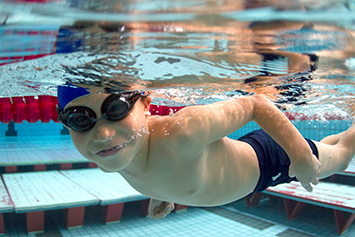
"For children (swimming goggles) there are lots of cute colours but they’re too small. Adults goggles are still a bit too big, and they don’t have cute colours." This came up when the developer was talking to a friend with a daughter in fifth grade elementary school about swimming goggles.
VIEW's children's goggles were designed for ages 4 to 9. And anyone over 10 years old fell into the adults range.
In addition to their school swimming classes, children in higher grades of elementary school, have a wide range of occasions where they should be using goggles, for example when visiting swimming pools with friends and family. The developer realised that despite this, there was no goggles for those ages. New sizes adapted to older elementary school children was derived from human composition analysis. However, creating goggles for higher grades in elementary school only by size and colour, would be insufficient from a functionality point of view. This older elementary school children also have other unique features. In order to find this answer, the developer started by observing children of this age.
Development staff visited the leisure pool and swimming competitions, and there they observed the children’s clothes, belongings, and swimming goggles.
They asked an acquaintance to introduce elementary school principals, and went on to conduct a survey of the students, finding out their interests and traits.
However, as expected, the developers could not find out what functionality they required.
Then one day, the development manager started remembering what he say, he also recalled his own childhood. He remembered watching the children swimming vigorously and playing. “When I was a kid, I used to swing my goggles around like that too, or drop them. I really didn't take care of them.”
Development staff focused once again on the behaviour of the children toward their goggles.
"If you handle it like that, the lens will be full of scratches." That is what they noticed as adults; something they did not notice when they were children. It is not good for your eyes to look through a damaged lens. It can negatively affect your vision. Thanks to this revelation, the development staff realised that a function to protect the lens would be necessary.
After trial and error, a few millimetres of protrusions were attached to the edge of the lens, avoiding direct contact with the lens surface even when dropped on the ground, and so reducing the possibility of scratches.
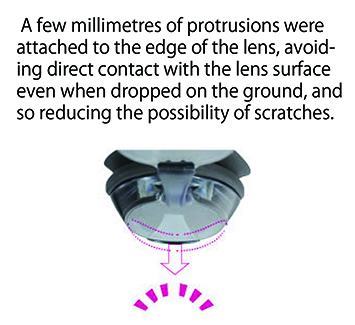
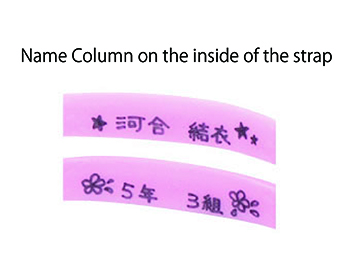
When children come out of the pool and are preparing to leave, their minds are busy with changing their clothes and chatting. Their goggles are the last thing on their mind. When a developer watched such a scene, he recalled losing his goggles as a child.
"A name space is absolutely necessary to prevent mistakes and losses, but simply writing your name on the strap don’t look cool, and is probably embarrassing”. As a member of the development team made this comment, a memory buried deep in his mind came back to him like a bad nightmare.
When on a school trip, he took a bath with his classmates. He had written his name on the waistband of his underwear where it was visible. A friend pointed it out, and he was embarrassed.
"Let's put a name column on the inside of the strap where it wont stand out.” This extra consideration of the development staff for children of that particular age provided another feature that would not effect the performance of the goggles.
Next, the development manager noticed another important point. "Huh? Do they wash their goggles?" “I don't remember washing them, just occasionally rinsing with water, nothing more."
So the development team placed antimicrobial materials on the face pad to keep them as clean as possible, and to increase their lifetime.
※ Antibacterial material is used, however, we recommend rinsing with fresh water after use, and hanging them in a dark place.
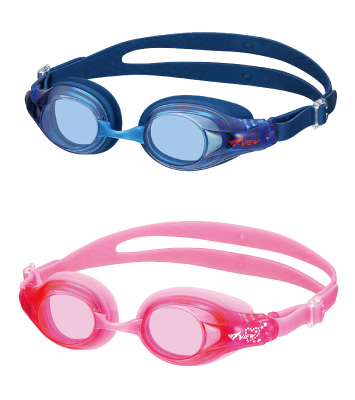
The number of children is decreasing due to the declining birthrate, but the cost to one child is getting higher.
Children's fashion and awareness of fashion is also growing, and this is linked to the growing costs.
Also, difference from a gender perspective between boys and girls of this age is remarkable. Because of this growing trend, Onishi proposed a specialised design for boys and girls.
For girls, metallic glitter was inserted in the buckle, and the logo was made as a hologram (excluding SK). Overall it was designed with attention to cuteness of details, making it stand apart from designs for adults.
For boys, they used a red one-point logo to suited to the energy and vitality of young boys. The packages for boys and girls have also been designed separately.
Following our interview, the team agreed that "If I had such high grade goggles as a child, I might have gone to the pool or might have gotten more used to the water." I would like older elementary school children to enjoy the pool time with these goggles.
Name space on the inside of the back of the strap doesn't compromise the design.
*Please note that ink may stain/smudge depending on ink used.
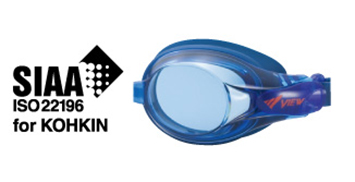
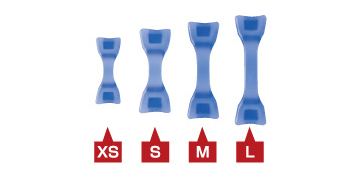
Hygienic anti-bacterial finish
SIAA recognised anti-bacterial coating. This is to reduce the rise of a multiple bacteria types. *While these goggles are protected by an anti-bacterial agent, we recommend rinsing with fresh water and hanging them to dry out of direct sunlight before storing.
SIAA ISO 22196 for KOHKIN
Face pad with antibacterial agent
Four nose belt sizes
There are four different lengths of nose belts (XS/S/M/L) provided as standard.
No need to compromise on design for the perfect fit!
*Standard size is set to M